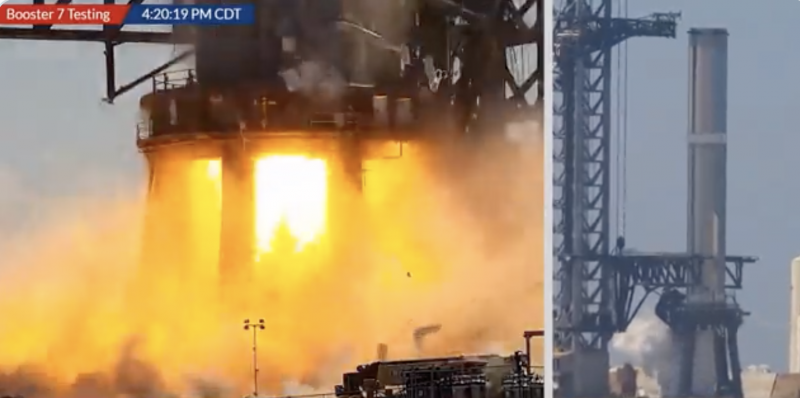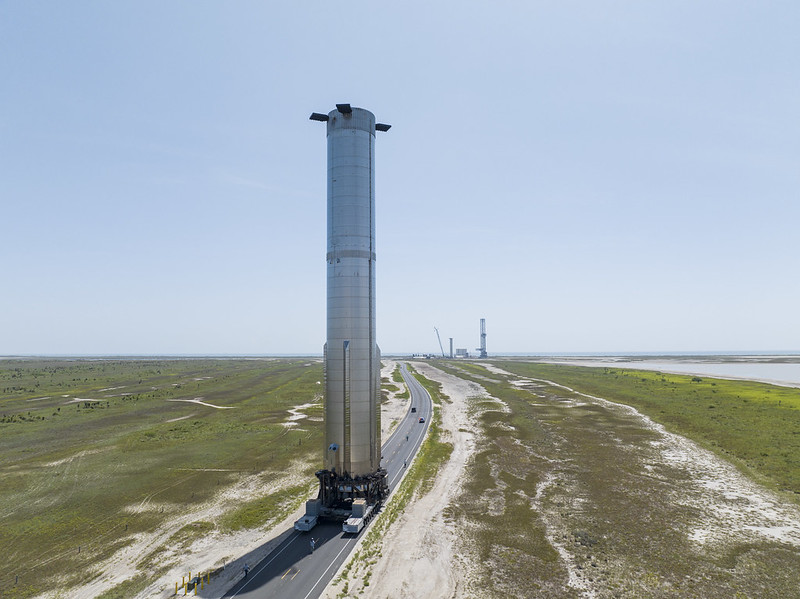
SpaceX assessing damage
Elon Musk has had a tough week. Twitter just said it was suing him, after Musk said he would exit the $44 billion acquisition deal announced in April. And on Monday (July 11, 2022), SpaceX had an unexpected fuel explosion during a static engine fire test of Booster 7, a prototype of Super Heavy, the first stage for SpaceX’s next-generation Starship deep-space transportation system. The explosion happened at the Starbase facility in Boca Chica, Texas.
A successful test of Booster 7’s 33 Raptor 2 engines is a key step on the path to an orbital test of Starship, the tallest and most powerful rocket yet constructed. That flight was expected as early as the end of July, but the launch schedule will likely be revised.
Musk: ‘Yeah, actually not good’
According to comments from the Everyday Astronaut, which maintains a live blog of events at Starbase, the explosion occurred at 4:20 p.m. CT (9:20 p.m. UTC). Moments later, Chris Bergin of NASASpaceflight.com tweeted a video of the explosion captured at close range. He expressed his utter surprise:
Holy moly. Well, that was unexpected!
Holy moly. Well, that was unexpected!https://t.co/dUUqw7ojRv pic.twitter.com/7IGztPuE12
— Chris Bergin – NSF (@NASASpaceflight) July 11, 2022
This prompted an understated reply from SpaceX CEO and chief engineer Elon Musk:
Yeah, actually not good. Team is assessing damage now.
Yeah, actually not good. Team is assessing damage.
— Elon Musk (@elonmusk) July 11, 2022
Booster 7 held up well … maybe
Immediately before the explosion, a cloud of dense white vapor began billowing from the bottom of Booster 7. The fog of volatiles hung in the air briefly, filling the space beneath the launch stand in moments. Then the cloud of fog exploded, surrounding the base of the vehicle and the tower in yellow-orange flame that gave way to a white smoke, which trailed away in the light breeze. Later, a fire broke out, bathing the now darkened scene in a glow from flames hidden from the cameras by surrounding equipment.
Hours later, when the ship’s remaining cryogenic fuel had been drained, Musk accompanied a team that made the initial damage assessment. Just after midnight local time on Tuesday (July 12, 2022), he tweeted the launch pad was off limits following the team’s quick visit to avoid potential lingering danger:
Base of the vehicle seems ok by flashlight. I was just out there about an hour ago. We shut down the pad for the night for safety. Will know more in the morning.
Base of the vehicle seems ok by flashlight. I was just out there about an hour ago. We shut down the pad for the night for safety. Will know more in the morning.
— Elon Musk (@elonmusk) July 12, 2022
Then around 1 a.m. CT Wednesday (July 13, 2022), Musk updated his Twitter with a video of Booster 7 being lifted off the pad and delivered the promised follow-up:
Was just up in the booster propulsion section. Damage appears to be minor, but we need to inspect all the engines. Best to do this in the high bay.
Was just up in the booster propulsion section. Damage appears to be minor, but we need to inspect all the engines. Best to do this in the high bay.
— Elon Musk (@elonmusk) July 13, 2022
Rocket science ain’t easy!
Further tweets from Musk give the impression the problem was caused by an accumulation of unburned propellant expelled from the 33 Raptor 2 engines that will power Starship boosters into space. Musk reminded his followers engineering a launch vehicle is never a simple task:
Cryogenic fuel is an added challenge, as it evaporates to create fuel-air explosion risk in a partially oxygen atmosphere like Earth.
Cryogenic fuel is an added challenge, as it evaporates to create fuel-air explosion risk in a partially oxygen atmosphere like Earth.
That said, we have a lot of sensors to detect this. More later.
— Elon Musk (@elonmusk) July 11, 2022
Responding to a follower who wondered if it would be prudent to follow NASA’s example – during the space shuttle era, the agency used radial outward firing ignitors (ROFIs or sparklers) to set off escaped fuel before it could accumulate – Musk said SpaceX will do the same. He also said SpaceX’s technicians may have overdone it with this particular test:
That is one of the things we will be doing going forward. This particular issue, however, was specific to the engine spin start test (Raptor has a complex start sequence). Going forward, we won’t do a spin start test with all 33 engines at once.
When will Starship fly?
While there was no set date for the first orbital test flight of Starship, the company had touted a target of as early as this month. With the assessment of damage to Booster 7 still underway, when Starship will finally circle the Earth for the first time is even more unclear.
It may be that damage to Booster 7, which is designed to withstand the rigors of being the most powerful rocket ever built, may have come out relatively unscathed and easily repaired. Or it could be totalled, and if that is the case, SpaceX has other super-heavy lift boosters in various stages of completion that could replace the damaged rocketship.
The Everyday Astronaut website maintains a calendar of events and expected milestones relating to Starship’s FAA approval and initial orbital flight. It still lists July as a possibility for liftoff.

Bottom line: A fuel explosion interrupted a static engine test of SpaceX’s Starship super-heavy-lift vehicle. The accident could delay this summer’s orbital test flight.
The post SpaceX assessing damage after Booster 7 explosion first appeared on EarthSky.
0 Commentaires